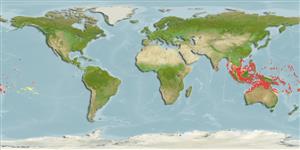>
Eupercaria/misc (Various families in series Eupercaria) >
Malacanthidae (Tilefishes)
Etymology: Hoplolatilus: Greek, hoplon = weapon + Latin, latus = wide (Ref. 45335).
Eponymy: Dr Walter Albert Starck II (d: 1939) is a marine biologist, ichthyologist and pioneer of coral reef research, who first pointed out the damselfish species to Allen while diving at Osprey Reef, Coral Sea. [...] (Ref. 128868), visit book page.
More on authors: Randall & Dooley.
Environment: milieu / climate zone / depth range / distribution range
экология
морской ассоциированный с рифами; пределы глубины 20 - 105 m (Ref. 9710), usually 20 - 50 m (Ref. 27115). Tropical; 21°C - 26°C (Ref. 27115); 19°N - 23°S
Indo Pacific: Bali, Indonesia, the Philippines to Timor, north to the Mariana Islands, south to Rowley Shoals and New Caledonia; throughout Micronesia. Range extends to Pitcairn (Ref. 9710).
Size / Вес / Возраст
Maturity: Lm ? range ? - ? cm
Max length : 15.5 cm TL самец/пол неопределен; (Ref. 90102)
колючие лучи спинного плавника (общее число) : 8; членистые (мягкие) лучи спинного плавника (общее число) : 21 - 23; колючие лучи анального плавника: 2; членистые (мягкие) лучи анального плавника: 15 - 16; позвонки: 24. Small juvenile bright blue (Ref. 48635). Preopercular serrae 30-57.
Inhabits patches of talus or rubble of steep outer reef slopes. Usually seen in pairs that quickly dive headfirst into their burrow when disturbed. Juveniles occasionally school with similarly colored juveniles of Pseudanthias pascalus. Stomach contents of 6 adult specimens consisted of copepods (31.4% by volume), pelagic tunicates (31%, larvaceans, plus Oikopleura), fish eggs (28.6%), siphonophores (5.5%), larval shrimps (1.2%), fish (0.8%), amphipods (0.7%), unidentified decapod larvae (0.5%), and heteropods (0.3) (Ref. 8991). Minimum depth reported from Ref. 27115.
Life cycle and mating behavior
половая зрелость | размножение | нерест | икра | Fecundity | личинки
Displays obligate monogamy where a one-to-one pair is established irrespective of resource abundance (Ref. 52884).
Randall, J.E. and J.K. Dooley, 1974. Revision of the Indo-Pacific branchiostegid fish genus Hoplolatilus, with descriptions of two new species. Copeia 1974(2):457-471. (Ref. 9870)
Статус Красного Списка МСОП (Ref. 130435: Version 2024-1)
Угроза для людей
Harmless
Использование человеком
рыболовство: коммерческий; аквариум: коммерческий
дополнительная информация
инструменты
Специальные отчеты
Скачать в формате XML
ресурсы в Интернет
Estimates based on models
Preferred temperature (Ref.
123201): 25.5 - 28.9, mean 27.7 °C (based on 362 cells).
Phylogenetic diversity index (Ref.
82804): PD
50 = 0.5001 [Uniqueness, from 0.5 = low to 2.0 = high].
Bayesian length-weight: a=0.01122 (0.00514 - 0.02450), b=3.04 (2.87 - 3.21), in cm total length, based on all LWR estimates for this body shape (Ref.
93245).
Trophic level (Ref.
69278): 3.5 ±0.0 se; based on diet studies.
Fishing Vulnerability (Ref.
59153): Low vulnerability (10 of 100).
Nutrients (Ref.
124155): Calcium = 84 [53, 138] mg/100g; Iron = 0.821 [0.533, 1.260] mg/100g; Protein = 18.2 [16.0, 20.2] %; Omega3 = 0.174 [0.113, 0.265] g/100g; Selenium = 30.1 [17.6, 53.3] μg/100g; VitaminA = 176 [69, 438] μg/100g; Zinc = 1.41 [1.00, 1.91] mg/100g (wet weight);
